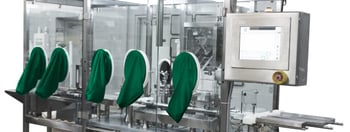In the midst of our current, ever-changing worldwide coronavirus crisis, the word on everyone’s mind is vaccine. Never before have the world’s scientific and pharmaceutical communities felt such a collective rush to bring life-saving vaccines to market. In today’s post, our resident filling systems and single-use technology expert, Dr. Laura Moody, provides an overview of the different types of vaccines, how they work, and how Syntegon’s fill-finish portfolio supports clinical and commercial manufacturing.
The intention behind a vaccine is to train the body’s immune cells to recognize a virus in advance, so that these cells are ready to mount a targeted and robust defense when infection occurs. In the case of COVID-19, it’s highly unlikely that there will be only one successful vaccine candidate for commercialization; there are many different types of vaccines, representing different strategies to teach the body’s immune system what an infectious invader looks like.
For a virus to replicate or make more of itself, it needs a host in the form of a living cell. The virus hijacks the cell’s machinery to create more of itself. In traditional vaccine manufacturing, which produces either inactivated or live attenuated vaccines, the first step is to grow the virus through an egg-based process. Eggs serve as primary cells for the viruses to live and divide within. After the virus replicates itself inside the eggs, fluid that contains the virus is harvested. When a vaccine is inactivated, the virus within the fluid collected from the eggs is killed, typically by heat or chemicals. Live attenuated vaccines are made by modifying the disease-producing virus in a laboratory. What results is a vaccine that is still able to multiply in the human body and trigger the immune response, but does not cause illness.
The rise in biotechnology has ushered in several new approaches to vaccine development. For recombinant vaccines, scientists isolate a particular surface protein from a virus and are able to determine the DNA sequence necessary to generate that specific viral protein. This DNA sequence is then combined with DNA portions of another virus that grows well in insect cells. The resulting recombination of genetic material from two viruses creates a recombinant virus that is mixed with insect cells and allowed to reproduce. When the recombinant virus enters the insect cells, it instructs the cells to quickly make the viral surface protein. The viral surface protein is then harvested from the cells, purified, and then packaged as a recombinant vaccine.
The emergence of nucleic acid vaccines is revolutionizing the vaccine field. DNA plasmid vaccines contain a small, circular piece of DNA called a plasmid that includes the gene(s) necessary to code for proteins specific to the virus. When a DNA vaccine is injected into the body, our cells read the genes and make the viral proteins, which assemble into non-infectious, virus-similar particles. Our body then mounts an immune response to these particles. Vaccines based on viral messenger RNA (mRNA, an intermediate between DNA and protein) are currently being developed. Short pieces of mRNA are used to inoculate against the disease, using the body’s cellular machinery to produce virus-specific protein. These virus-specific proteins then trigger the body’s immune response.
No matter the type of vaccine being manufactured, all must undergo a final formulation by adding adjuvant (substances that enhance the body’s immune response), stabilizers (to increase storage life) and/or preservatives (to allow the use of multidose vials). After formulation, the vaccine is ready to be packaged in its final container, whether it be a vial, syringe or ampoule.
Syntegon has multiple options for aseptic final fill into any of the containers used in vaccine manufacture. For the production of small batches used in clinical trials, the FLT vial filler in a standard RABS configuration can be available in six months or less. For vaccines in commercial production, Syntegon offers syringe filling with the FXS series, capable of filling up to 960 syringes/minute. High speed filling of both vials and ampoules is possible on the ALF series, with filling speeds up to 600 containers/minute. The FSC series is available for ultra-high speed vial filling, at 750 vials/minute. Whatever the technical demand, Syntegon is here to support the worldwide manufacture of life-saving vaccines.
Interested in learning more? Contact your regional sales representative today! Our subject matter experts are available to engage on your specific application.
Sources:
https://www.cdc.gov/flu/prevent/how-fluvaccine-made.htm
https://www.niaid.nih.gov/research/vaccine-types
https://www.who.int/biologicals/areas/vaccines/dna/en/
Laura holds a Ph.D. in cellular and molecular biology. She is Syntegon’s filling systems and single-use technology expert.


